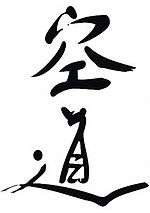Kūdō
Kūdō (空道, Kūdō) (formerly Kakutō karate (格闘空手); often Daidōjuku) is a Japanese hybrid martial art. It is full-contact mixed combat sport with head Guard and gloves, throwing and grappling techniques are also allowed in the competition, including restraint, locks and strangle holds. It can be called a mixed martial art with protective gear for the head.[1]
 | |
| Date founded | 1981 |
|---|---|
| Country of origin | |
| Current head | Azuma Takashi |
| Ancestor arts | Karate, Judo, Boxing |
| Official website | http://ku-do.com |
The goal of Kūdō is to come as close as possible to realistic, real fighting, with appropriate protective clothing. To achieve this, Kūdō is fought with very few regulations, and has specialised techniques and actions. The techniques of Kūdō include the entire spectrum of a real struggle-fighting standing up, throwing techniques, grappling and ground fighting.
The training of Kūdō consists primarily of kihon, general fitness training and combat. The kata of Kyokushin were eliminated without replacement.
Kūdō is a comprehensive martial art and philosophy, in which both the physical as well as mental development are considered. Traditional Japanese etiquette Budo (as Reigi) is followed, there are certain Japanese greeting ritual, a traditional training keikogi is worn, the names of the techniques are in Japanese, etc.
.png)
Kūdō is practised in more than 52 countries, with the largest representation in Russia.
Takashi Azuma

Takashi Azuma (東 孝, Azuma Takashi) (born 1949 in Kesennuma, Japan) is the founder of Kūdō[2][3] and the President of the Kudo International Federation. He currently holds an 9th degree black belt in Kyokushin Budokai (awarded by Jon Bluming), a 3rd degree black belt in judo, and a 9th degree black belt in Kūdō.
Azuma came in contact with budo for the first time when he entered the judo club of his school in Kesennuma at the age of 16 in 1965. In 1972 after his service in the Japanese armed forces, he joined Kyokushin Karate. That same year he founded a Kyokushin dan at Waseda University.[4]
In 1981, Azuma founded his own martial art because he was unhappy with some characteristics of Kyokushin. Azuma was bothered that in Kyokushin serious head injuries are common. Azuma was also of the opinion that physically smaller fighters are at a disadvantage compared to bigger fighters.
Azuma's own development of a martial art was first a hybrid of Kyokushin Karate and Judo. Kyokushin was the basis, however, the regulations changed dramatically. Protective clothing was introduced, which allowed hand techniques to the head, and provides sufficient protection to the head during kicking techniques. Selected techniques of grappling and ground combat have been added from judo.
Famous practitioners
- Semmy Schilt, mixed martial artist and kickboxer. Hokutoki champion in 1996 and 1997.
- Yoshinori Nishi, mixed martial arts fighter and founder of the Wajyutsu Keishukai gym. Hokutoki champion in 1984 and 1985.
- Lee Hasdell, mixed martial artist and kickboxer.
- Katsumasa Kuroki, professional wrestler.
- Minoki Ichihara, mixed martial artist and Ultimate Fighting Championship competitor.
- Hisaki Kato, Mixed Martial Artist who compete in Bellator MMA and Kickboxing.
- Akshay Kumar Bollywood super star and martial artist.
- Taapsee Pannu Bollywood actress and martial artist.
Equipment
Kudo practitioners use white and blue Gi colors for easy identification along with independently developed protective gear (face, torso, arms, legs, etc.) to ensure athletes safety.
All athletes must wear dogi, headgear, kudo fist guard and kudo bandage.
Dojo kun
Dōjō kun is a Japanese martial arts term literally meaning (training hall) rules. They are generally posted at the entrance to a dōjō or at the "front" of the dojo (shomen) and outline behaviour expected and disallowed.
The dojo kun of kudo is the following:
Through the pursuit of Kudo, we develop great physical and mental strength, educate ourselves and gain intelligence, and bond with people and enrich our emotions. Therefore, we shall be able to cultivate our personalities and become positively contributing members of society.
References
- "Kudo International Federation - KIF is a governing organization for "KUDO", mixed Budo sport". Ku-do.com. Retrieved 2016-10-20.
- "Panamericano de Kudo en Chile será dirigido por su fundador". Terra Chile.
- "Kudo: El gran camino para tener una mente abierta". El País.
- "Archived copy". Archived from the original on 2013-10-19. Retrieved 2016-10-17.CS1 maint: archived copy as title (link)